*NURSING > NCLEX-RN > NCLEX-RN Review - Test 7 - The Client with Biliary Tract Disorders. 20 Questions and Answers. (All)
NCLEX-RN Review - Test 7 - The Client with Biliary Tract Disorders. 20 Questions and Answers.
Document Content and Description Below
HERE ARE THE QUESTIONS: NCLEX-RN Review - Test 7 - The Client with Biliary Tract Disorders A client has undergone a laparoscopic cholecystectomy. Which instruction should the nurse include in the dis... charge teaching? 1. Empty the bile bag daily. 2. Breath deeply into a paper bag when nauseated. 3. Keep adhesive dressings in place for 6 weeks. 4. Report bile-colored drainage from any incision. 4. Report bile-colored drainage from any incision. There should be no bile-colored drainage coming from any of the incisions postoperatively. A laparoscopic cholecystectomy does not involve a bile bag. Breathing deeply into a paper bag will prevent a person from passing out due to hyperventilation; it does not alleviate nausea. If the adhesive dressings have not already fallen off, they are removed by the surgeon in 7-10 days, not 6 weeks. A client with acute cholecystitis has severe pain. Which prescription will be most effective in relieving the pain? 1. infusing normal saline solution at 100mL/hr 2. administering morphine sulfate 10mg IM every 3-4 hours 3. receiving nothing by mouth (NPO) 4. having a nasogastric tube connected to low intermittent suction 2. administering morphine sulfate 10mg IM every 3-4 hours The client is in severe pain & the nurse should administer the morphine to relieve the pain. The client will receive IV fluids to maintain fluid & electrolyte balance, but that will not relieve the pain. The client may be NPO & have a NG tube to promote gastric decompression to prevent further gallbladder stimulation, but these are not sufficient to manage pain. A client is admitted to the hospital with a diagnosis of cholecystitis. The client has severe abdominal pain & nausea & has vomited o120mL. Based on these date, which nursing action would have the highest priority at this time? 1. Manage anxiety. 2. Restore fluid loss. 3. Manage the pain. 4. Replace nutritional loss. 3. Manage the pain. The priority for nursing care at this time is to decrease the client's severe abdominal pain. The pain, which is frequently accompanied by nausea & vomiting, is caused by biliary spasm. Opioid analgesics are given to relieve the severe pain & spasm of cholecystitis. Relief of pain may decrease nausea & vomiting & thereby decrease the client's likelihood of developing further complications, such as severe fluid loss & inadequate nutrition. There are no data to suggest that the client is anxious. The client's stools are light gray in color. What additional information should the nurse obtain from the client? Select all that apply. 1. intolerance of fatty foods 2. fever 3. jaundice 4. respiratory distress 5. pain at McBurney's point 6. bleeding ulcer 1. intolerance of fatty foods 2. fever 3. jaundice Bile is created in the liver, stored in the gallbladder & released into the duodenum, giving stool its brown color. A bile duct obstruction can cause pale-colored stools. Other symptoms associated with cholelithiasis are right upper quadrant tenderness, fever from inflammation or infection, jaundice from elevated serum bilirubin levels & nausea or right upper quadrant pain after a fatty meal. Pain as McBurney's point lies between the umbilicus & right iliac crest & is associated with appendicitis. A bleeding ulcer produces black, tarry stools. Respiratory distress is not a symptom of cholelithiasis. A client who has been scheduled to have a choledocholithotomy expresses anxiety about having surgery. Which nursing intervention would be the most appropriate to achieve the outcome of anxiety reduction? 1. providing the client with information about what to expect postoperatively 2. telling the client not to be afraid 3. reassuring the client by saying that surgery is a common procedure 4. stressing the importance of following the health care provider's instructions after surgery 1. providing the client with information about what to expect postoperatively Providing information can help to answer the client's questions & decrease anxiety. Fear of the unknown can increase anxiety. Telling the client not to be afraid, that the procedure is common, or to follow the HCP's prescriptions will not necessarily decrease anxiety. A client has an open cholecystectomy with bile duct exploration. Following surgery, the client has a T tube. What should the nurse do to determine the effectiveness of the T tube? 1. Irrigate the tube with 20mL of normal saline every 4 hours. 2. Unclamp the T tube & empty the contents every day. 3. Assess the color & amount of drainage every shift. 4. Monitor the incision sites for bile drainage. 3. Assess the color & amount of drainage every shift. A T tube is inserted in the common bile duct to maintain patency when there is a likelihood of edema. The tube remains in place until edema from the duct exploration subsides. The bile color should be gold to dark green & the amount of drainage should be closely monitored to ensure tube patency. Irrigation is not routinely done, unless prescribed using a smaller volume of fluid. The T tube is not clamped in the early postop period to allow for continuous drainage. An open cholecystectomy has one right subcostal incision, whereas a laparoscopic cholecystectomy has multiple small incisions. At 0800, the nurse reviews the amount of T-tube drainage for a client who underwent an open cholecystectomy yesterday. After reviewing the output record (see chart), what should the nurse do next? Output Record Time T-Tube 1200 50mL 1600 60mL 2000 60mL 0000 70mL 0400 70mL 0800 10mL 1. Report the 24-hour drainage amount at 1200. 2. Clamp the T tube. 3. Evaluate the tube for patency. 4. Irrigate the T tube. 3. Evaluate the tube for patency. The T tube should drain approximately 300-500mL in the first 24 hours & after 3-4 days the amount should decrease to <200mL in 24 hours. With the sudden decrease in drainage at 0800, the nurse should immediately assess the tube for obstruction of flow that can be caused by kinks in the tube or the client lying on the tube. Drainage color must also be assessed for signs of bleeding. The tube should not be irrigated or clamped without a prescription. A client who had a cholecystectomy has a T-tube for drainage. The nurse measures the amount of bile drainage from the T tube at the end of each shift. How should the nurse record the drainage? 1. adding it to the client's urine output 2. charting it separately on the output record 3. adding it to the amount of wound drainage 4. subtracting it from the total intake for each day 2. charting it separately on the output record T-tube bile drainage is recorded separately on the output record. Adding the T-tube drainage to the urine output or wound drainage makes it difficult to accurately determine the amounts of bile, urine, or drainage. The client's total intake will be incorrect if drainage is subtracted from it. The nurse is caring for a client who had an open cholecystectomy 24 hours ago. The client's vital signs have been stable over the last 24 hours, with most recent temperature 98.6, blood pressure 118/76mmHg, respiratory rate 16 breaths/min, & heart rate 78bpm, but these signs are now changing. Which set of vital signs indicates that the nurse should contact the health care provider? 1. 101.8-94-24-140/86 2. 100.7-84-20-118/68 3. 99.5-58-16-126/80 4. 97.5-98-18-98/64 1. 101.8-94-24-140/86 This client is exhibiting signs of sepsis, and the nurse should notify the HCP. The client has 3 signs indicating sepsis: temperature >101.0, HR >90bpm, RR >20bpm. At least 2 of these variables are required to diagnose sepsis. After a cholecystectomy, the client is to follow a low-fat diet. Which food would be most appropriate to include in a low-fat diet? 1. cheese omelet with onions 2. peanut butter on wheat toast 3. ham salad sandwich made with mayonnaise 4. roast beef sandwich with lettuce & tomato 4. roast beef sandwich with lettuce & tomato Lean meats, such as beef, lamb, veal, & well-trimmed lean ham & pork, are low in fat. Rice, pasta, & vegetables are low in fat when not served with butter, cream, or sauces. Fruits are low in fat. The amount of fat allowed in a client's diet after a cholecystectomy will depend on the client's ability to tolerate fat. Typically, the client does not require a special diet but is encouraged to avoid excessive fat intake. A cheese omelet & peanut butter have high fat content. Ham salad is high in fat from the fat in a mayonnaise-based salad dressing. A client with cholecystitis has severe pain unrelieved by ibuprofen. The client feels nauseated. The nurse obtains the following vitals signs: 101.1-114-22-142/90. Using SBAR (Situation-Background-Assessment-Recommendation) technique for communication, what should the nurse recommend to the HCP for this client? 1. a medication for severe pain 2. a medication for increased temperature 3. a medication for elevated blood pressure 4. a medication for feelings of nausea 1. a medication for severe pain The client has severe pain, & the nurse should contact the HCP for pain medication. An opioid such as morphine is usually prescribed intravenously to manage the severe pain. Elevation of heart rate & blood pressure is likely due to the pain. The pain medication may also relieve the nausea. The nurse prepares to administer promethazine 35mg IM prescribed as needed for a client with cholecystitis who has severe nausea. The ampule label reads that the medication is available in 25mg/mL. How many milliliters should the nurse administer? Record your answer using one decimal place. ______________________mL The following formula is used to calculate the correct dosage: 35mg/XmL = 25mg/1mL X=1.4mL A client undergoes a laparoscopic cholecystectomy. Which instructions should the nurse give the client about a diet immediately after surgery? 1. "You can't eat or drink anything for 24 hours." 2. "You may resume your normal diet the day after your surgery." 3. "Start with liquids & see how you feel." 4. "You can progress from a liquid to a bland diet as tolerated." 3. "Start with liquids & see how you feel." Immediately after surgery, the client can drink liquids. A light or regular diet can be resumed when the client can tolerate the liquids. There is no need for the client to remain on NPO status after surgery because peristaltic bowel activity should not be affected. The client will probably not be able to tolerate a full meal comfortably the day after surgery. There is no need for the client to stay on a bland diet after a laparoscopic cholecystectomy. The client should, however, avoid excessive fats. Which discharge instruction would be appropriate for a client who has had a laparoscopic cholecystectomy & has sutures covered by a dressing? 1. Avoid showering for 1 week after surgery. 2. Return to work within 1 week. 3. Leave dressing in place until seeing the surgeon at the postoperative visit. 4. Use acetaminophen to control any fever. 3. Leave dressing in place until seeing the surgeon at the postoperative visit. After a laparoscopic cholecystectomy when there are sutures covered by a dressing, the client should not remove dressings from the puncture sites but should wait until visiting the surgeon. The client may shower 48 hours after surgery. A client can return to work within 1 week, but only if approved by the surgeon & no strenuous activity is involved. The client should report any fever, which could be an indication of a complication. A client who has had a laparoscopic cholecystectomy has adhesive strips over the puncture sites. When preparing the client for discharge, which client statements indicate that the teaching has been successful? Select all that apply. 1. "I can resume my normal diet when I feel ok." 2. "I need to avoid driving for about 4 weeks." 3. "I may experience some pain in my right shoulder." 4. "I should spend 2-3 days in bed before resuming activity." 5. "I can take a shower 2 days later." 1. "I can resume my normal diet when I feel ok." 3. "I may experience some pain in my right shoulder." 5. "I can take a shower 2 days later." Following a laparoscopic cholecystectomy, the client can resume a normal diet as tolerated. The client may experience right shoulder pain from the gas that was used to inflate the abdomen during surgery. The client can take a shower 48 hours after the surgery. The adhesive strips will fall off in about 10 days. The client can resume driving within 3-4 days following surgery as long as the client is not taking pain medication. There is no need for the client to maintain bed rest in the days following surgery. Light exercise such as walking can be resumed immediately. Following an emergency cholecystectomy, the client has a Jackson-Pruitt drain with closed suction. After 4 hours, the drainage unit is full. What should the nurse do? 1. Notify the surgeon. 2. Remove the drain & suction unit. 3. Check the dressing for bleeding. 4. Empty the drainage unit. 4. Empty the drainage unit. Portable suction units should be emptied & drained every shift or when full. It is normal for the unit to fill within the first hours after surgery. The nurse does not need to contact the surgeon. There should not be bleeding on the dressing of the drainage if the drainage system is emptied when full. The drain should not be removed until prescribed by the HCP. The client who has been hospitalized with pancreatitis does not drink alcohol because of religious convictions. The client becomes upset when the HCP persists in asking about alcohol intake. What should the nurse tell the client about the reason for these questions? 1. "There is a strong link between alcohol use & acute pancreatitis." 2. "Alcohol intake can interfere with the tests used to diagnose pancreatitis." 3. "Alcoholism is a major health problem & all clients are questioned about alcohol intake." 4. "The HCP must obtain the pertinent facts, regardless of religious beliefs." 1. "There is a strong link between alcohol use & acute pancreatitis." Alcoholism is a major case of acute pancreatitis in the US & Canada. Because some clients are reluctant to discuss alcohol use, staff may inquire about it in several ways. Generally, alcohol intake does not interfere with the tests used to diagnose pancreatitis. Recent ingestion of large amounts of alcohol, however, may cause an increased serum amylase level. Large amounts of ethyl & methyl alcohol may produce an elevated urinary amylase concentration. All clients are asked about alcohol & drug use on hospital admission, but this information is especially pertinent for clients with pancreatitis. HCPs do need to seek facts, but this can be done while respecting the client's religious beliefs. Respecting religious beliefs is important in providing holistic client care. A client with acute pancreatitis has a blood pressure of 88/40mmHgo, heart rate of 128bpm, respirations of 28breaths/min, & Grey Turner's sign. What prescription should the nurse implement first? 1. Initiate intake/output record. 2. Place an intravenous line. 3. Position on the left side. 4. Insert a nasogastric tube. 2. Place an intravenous line. Grey Turner's sign is a bluish discoloration in the flank area caused by retroperitoneal bleeding. The vital signs are showing hemodynamic instability. IV access should be obtained to provide immediate volume replacement. The urine output will provide information on the fluid status. A nasogastric tube is indicated for clients with uncontrolled nausea & vomiting or gastric distension. Repositioning the client may be considered for pain management once the client's vital signs are stable. Which of the following indicates that the desired outcome was reached following transfusion for acute pancreatitis? 1. BP 110/80 2. Pain 4/10 3. Hemoglobin 12 4. Platelet 144,000 3. Hemoglobin 12 PRBCs are prescribed to improve the low hemoglobin level; therefore, the nurse assesses for an increase in hemoglobin. The PRBCs do not increase BP; colloid solutions are needed to increase the circulating blood volume & raise the BP. The client has acute pain & requires the use of analgesia to minimize the pain. The platelet count is within normal limits & is not affected by the infusion of PRBCs. The nurse should monitor the client with acute pancreatitis for which complication? 1. heart failure 2. duodenal ulcer 3. cirrhosis 4. pneumonia 4. pneumonia The client with acute pancreatitis is prone to complications associated with the respiratory system. Pneumonia, atelectasis & pleural effusion are examples of respiratory complications that can develop as a result of pancreatic enzyme exudate. Pancreatitis does not cause heart failure, ulcer formation, or cirrhosis. [Show More]
Last updated: 1 year ago
Preview 1 out of 11 pages
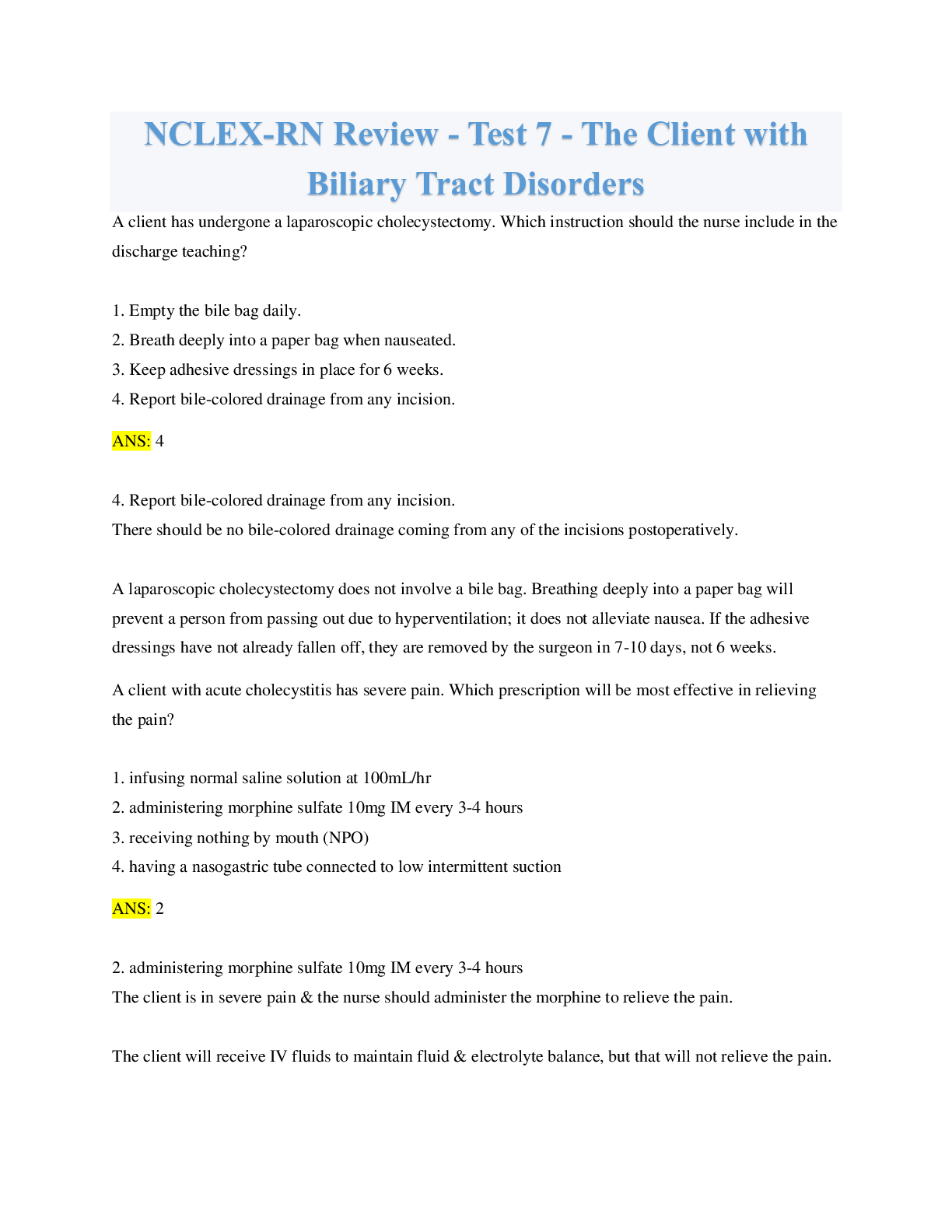
Reviews( 0 )
Recommended For You
*NURSING> NCLEX-RN > Actual tests NCLEX-RN Compilation. (All)
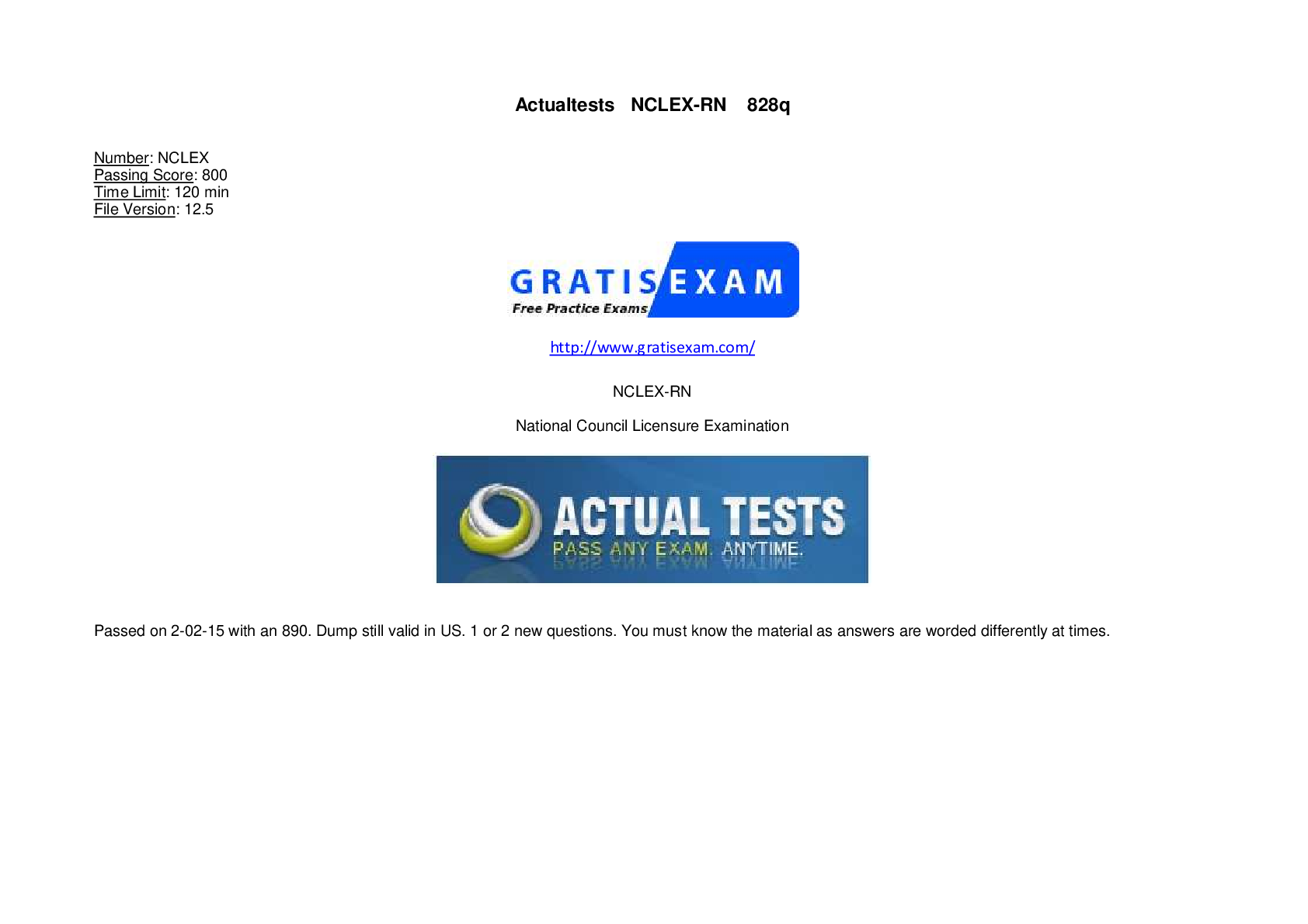
Actual tests NCLEX-RN Compilation.
NCLEX-RN QUESTION 1 A 25-year-old client believes she may be pregnant with her first child. She schedules an obstetric examination with the nurse practitioner to determine the status of her possibl...
By Cheryshev , Uploaded: Sep 12, 2021
$30
*NURSING> NCLEX-RN > TEST BANK NCLEX QUESTIONS AND ANSWERS ALL UPDATED (All)

TEST BANK NCLEX QUESTIONS AND ANSWERS ALL UPDATED
ST BANK NCLEX QUESTIONS AND ANSWERS ALL UPDATED WELL 2021 QUESTIONS 1-15 Ref # 4366 The nurse receives a client from the post anesthesia care unit following a left femoral-popliteal bypass gr aft proc...
By Expert , Uploaded: Mar 14, 2021
$12
*NURSING> NCLEX-RN > NCLEX RN Cardiovascular 150 Q&A. The most commonly tested exam questions. (All)
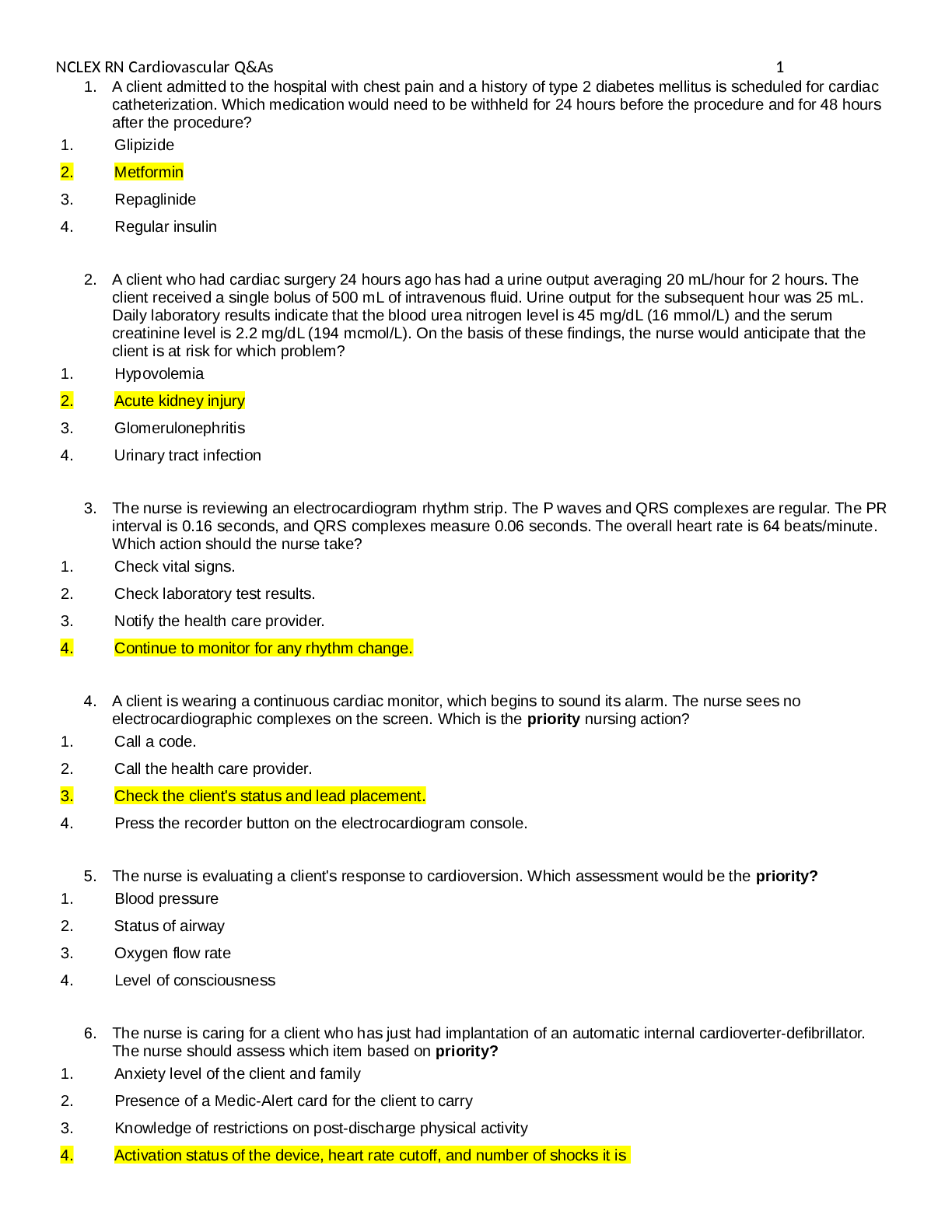
NCLEX RN Cardiovascular 150 Q&A. The most commonly tested exam questions.
NCLEX RN Cardiovascular 150 Q&As 1. A client admitted to the hospital with chest pain and a history of type 2 diabetes mellitus is scheduled for cardiac catheterization. Which medication would ne...
By QuizMaster , Uploaded: Aug 20, 2020
$10
*NURSING> NCLEX-RN > TEST BANK NCLEX QUESTIONS AND ANSWERS (All)

TEST BANK NCLEX QUESTIONS AND ANSWERS
TEST BANK NCLEX QUESTIONS AND ANSWERS ALL UPDATED WELL 2021 QUESTIONS 1-15 Ref # 4366 The nurse receives a client from the post anesthesia care unit following a left femoral-popliteal bypass gr...
By klaus , Uploaded: Jan 25, 2021
$12
*NURSING> NCLEX-RN > ATI NCLEX RN Comprehensive Predictor 2019 Form A. ATI NCLEX Predictor. Contains 180 Q&A for nursing school personnel and students to Guarantee success on the NCLEX. (All)

ATI NCLEX RN Comprehensive Predictor 2019 Form A. ATI NCLEX Predictor. Contains 180 Q&A for nursing school personnel and students to Guarantee success on the NCLEX.
RN Comprehensive Predictor 2019 Form A 1. A nurse in a pediatric unit is preparing to insert an IV catheter for 7-year-old. Which of the following actions should the nurse take? A. (Unable to re...
By QuizMaster , Uploaded: Aug 16, 2020
$9
*NURSING> NCLEX-RN > SAUNDERS NCLEXRN EXAMINATION REVISON CONTENT. QUESTIONS AND ANSWERS (All)
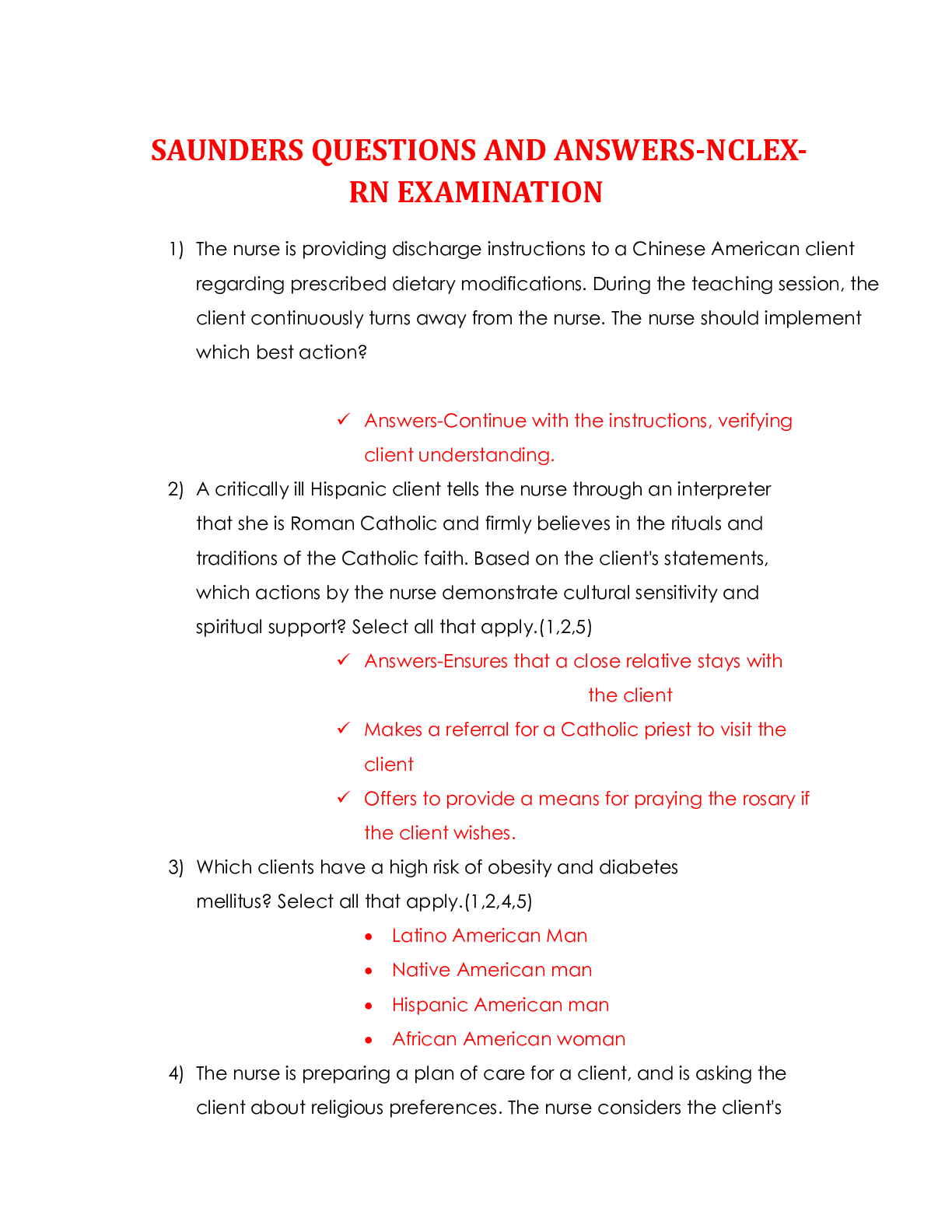
SAUNDERS NCLEXRN EXAMINATION REVISON CONTENT. QUESTIONS AND ANSWERS
SAUNDERS QUESTIONS AND ANSWERS-NCLEX-RN EXAMINATION 1) The nurse is providing discharge instructions to a Chinese American client regarding prescribed dietary modifications. During th...
By QuizMaster , Uploaded: Aug 05, 2020
$9
*NURSING> NCLEX-RN > NCLEX RN & CGFNS Gastrointestinal Disorders Q&A. 200 Most Commonly tested Questions from Week 1 to 13- NC III (All)

NCLEX RN & CGFNS Gastrointestinal Disorders Q&A. 200 Most Commonly tested Questions from Week 1 to 13- NC III
NCLEX-RN & CGFNS Practice Question » Gastrointestinal Disorders Questions in Power points from Week 1 to 13- NC III Adequate nutrition is required for healing after treatment for recurrent aphtho...
By SuperSolutions© , Uploaded: Nov 28, 2020
$12
*NURSING> NCLEX-RN > NCLEX-RN Cram Sheet: This NCLEX-RN cram sheet or cheat sheet can help you prepare as it contains condensed facts about the nurse licensure exam itself and key nursing information: (All)
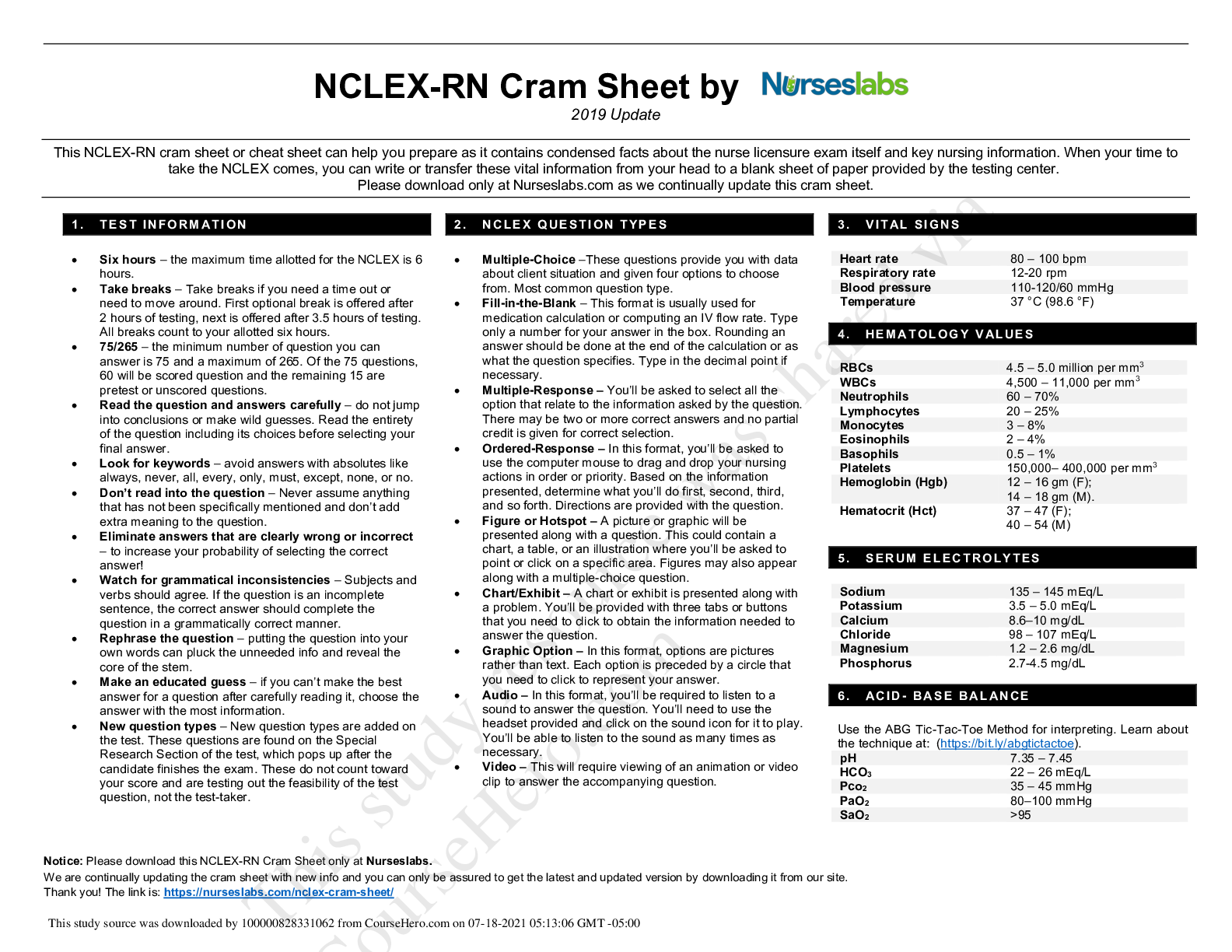
NCLEX-RN Cram Sheet: This NCLEX-RN cram sheet or cheat sheet can help you prepare as it contains condensed facts about the nurse licensure exam itself and key nursing information:
RBCs 4.5 – 5.0 million per mm3 NCLEX-RN Cram Sheet by 2020 Update This NCLEX-RN cram sheet or cheat sheet can help you prepare as it contains condensed facts about the nurse licensure exam itself and...
By Tutor Frankline , Uploaded: Jul 18, 2021
$9.5
*NURSING> NCLEX-RN > NCLEX RN ACTUAL EXAM TEST BANK OF REAL QUESTIONS & ANSWERS NCLEX 2023/2024 (All)

NCLEX RN ACTUAL EXAM TEST BANK OF REAL QUESTIONS & ANSWERS NCLEX 2023/2024
NCLEX RN ACTUAL EXAM TEST BANK OF REAL QUESTIONS & ANSWERS NCLEX 2023/2024
By GradesProff , Uploaded: Jul 19, 2023
$16
*NURSING> NCLEX-RN > NCLEX-RN EXAM QUESTIONS AND ANSWERS (LATEST VERSION) (All)
NCLEX-RN EXAM QUESTIONS AND ANSWERS (LATEST VERSION)
2022/2023 NCLEX-RN EXAM QUESTIONS AND ANSWERS (LATEST VERSION)/////////////2022/2023 NCLEX-RN EXAM QUESTIONS AND ANSWERS (LATEST VERSION)/////////2022/2023 NCLEX-RN EXAM QUESTIONS AND ANSWERS (LATEST...
By Rixx Dennis , Uploaded: Jun 02, 2022
$28
Document information
Connected school, study & course
About the document
Uploaded On
Mar 11, 2022
Number of pages
11
Written in
Additional information
This document has been written for:
Uploaded
Mar 11, 2022
Downloads
0
Views
192






